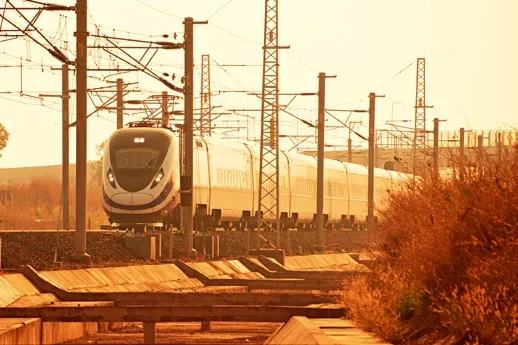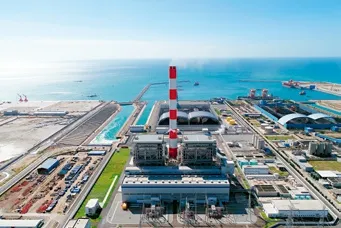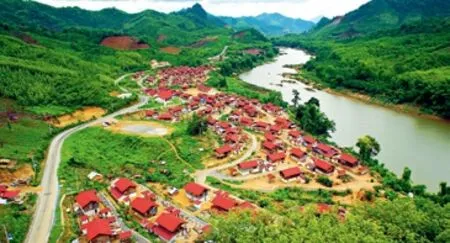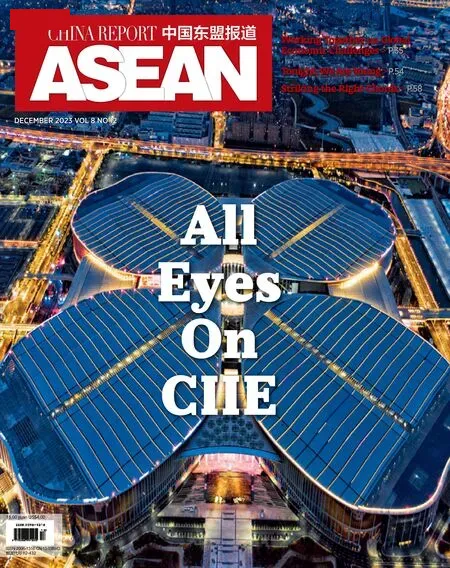A Decade of Lancang-Mekong Energy Cooperation
By Gong Daqian,Huang Yu,and Qin Yun

A Lane Xang EMU train approaches Vientiane Station of the China-Laos Railway on the morning of February 23,2023.(VCG)
This year marks the 10th anniversary of China’s proposal of the Belt and Road Initiative (BRI).In his speech at the opening ceremony of the Third Belt and Road Forum for International Cooperation in October,Chinese President Xi Jinping said that over the last 10 years,China has endeavored to build a global network of connectivity consisting of economic corridors and power grids.Hydroelectric,wind,and solar power plants,oil and gas pipelines,and increasingly smart and interconnected power transmission networks built in the Belt and Road countries are overcoming development bottlenecks caused by energy shortages and fulfilling the dream of developing countries to achieve green and lowcarbon development.These energy projects have become lighthouse for sustainable development in the new era.
The six Lancang-Mekong countries—China,Laos,Myanmar,Cambodia,Vietnam,and Thailand—are located in the China-Indochina Peninsula economic corridor,one of the six major economic corridors within the framework of the BRI.The countries are linked by mountains and rivers and share cultural affinity,good neighborliness,and strong friendship.Closely interconnected development interests among these countries have made the Lancang-Mekong region an important region for Belt and Road cooperation.

Phase I of the Vinh Tan thermal power plant BOT project by the China Southern Power Grid Company,which is expected to be the most advanced energy base in Vietnam upon completion.
Over the past decade,governments,industries,enterprises,and people of Lancang-Mekong countries have all participated in Belt and Road cooperation.Multi-party cooperation has yielded fruitful results including the construction of benchmark green energy projects that are brimming with vigor and vitality,which has injected strong impetus into mutual trust and economic development in the region and contributed to building a closer community of shared future for Lancang-Mekong countries.
Green Power Connectivity
Lancang-Mekong countries have actively promoted power connectivity across mountains,rivers,and borders,seeking to make clean green power play a bigger role on a larger scale.
As of September 2023,Lancang-Mekong countries had completed construction of 55 transmission lines at voltage levels of 110 kV and above.In recent years,the annual electricity trade among the countries reached 43 billion kWh,near the total amount of electricity consumed in Laos,Myanmar,and Cambodia.Mutual assistance in power supply has brought benefits to more remote areas,including some that had never had access to electricity before.
Southern Chinese regions such as Yunnan and Guangxi together share a 5,000-km border with Laos,Myanmar,and Vietnam.Over the last 10 years,Yunnan and Guangxi have launched several high-voltage power grid interconnection projects with these three neighboring countries.So far,15 cross-border transmission lines at voltage levels of 110 kV and above have been built,and the cumulative traded electricity over the past decade has exceeded 35 billion kWh.The power supply from China Southern Power Grid Company has illuminated the road to win-win power cooperation between China and its neighboring countries and contributed to a closer community of shared future.
Building Model Power Projects
Shortly after the BRI was first proposed in 2013,then Chinese Premier Li Keqiang and Vietnamese Prime Minister Nguyen Tan Dung facilitated issuance of an investment license to the China Southern Power Grid Company for the Vinh Tan thermal power plant from Vietnam’s Ministry of Planning and Investment.The largest power infrastructure investment project involving Chinese enterprises in Vietnam officially kicked off.
After the establishment of a joint venture between China Southern Power Grid Company,China Power International Development Limited,and Vietnam Coal Power Limited,more Chinese power enterprises joined the project.For example,China Energy Engineering Group Company was responsible for design and construction,China Dongfang Electric Corporation supplied equipment,China Harbour Engineering Company handled civil engineering,and China State Construction Engineering Group Company oversaw building operations.Many more related units responsible for logistics,testing,and supervision also contributed to the joint effort.
The Vinh Tan power plant can generate 8.36 billion kWh of electricity for sale every year,the largest among that type of power plant in Vietnam.It has met 3.5 percent of the demand for electricity of the whole country,which has to a certain extent ensured a steady flow of power for the leapfrog development of Vietnam in recent years.For Vietnam,the power plant has effectively eased the power shortage in its southern regions.It has also created more than 5,000 jobs and generated an annual revenue of more than US$20 million,injecting strong momentum into social and economic development.For China,the project has led more than 108 equipment manufacturing enterprises and dozens of infrastructure construction enterprises into the international market,with more than 78 Chinese standards being applied in Vietnam.It is a milestone of Belt and Road power cooperation.
The Vinh Tan power plant is a high-quality project of the Belt and Road energy and power cooperation and a vivid demonstration of advanced Chinese electric power manufacturing,construction,and management.It has brought remarkable economic and social benefits to both China and Vietnam.
Pham Minhha,chief quality supervisor of Vietnam’s National Acceptance Committee,assessed the project as “the best quality thermal power plant in Vietnam.” The project also won several awards in Vietnam including the “2019 Industrial and Commercial&Economic and Social Contribution Award” from Binh Thuan Province,where the project is located.
The China-Laos Railway,the first electrified railway in Laos,is a landmark project of high-quality Belt and Road cooperation and a flagship project of mutually beneficial cooperation.As of October 2023,26.8 million tons of goods had been transported on the railway with a cumulative value of over 2.2 billion yuan (US$340 million).It has been “a road to prosperity,” producing tangible benefits for the people along the route.
The successful and stable operation of the railway would not have been possible without the secure and reliable power supply facilities along the route built and maintained by Chinese power companies.To provide sufficient power for the scheduled operation of the railway,China Southern Power Grid Company and Electricite du Laos jointly built 936 kilometers of transmission lines and 2,220 base towers.More than half of the lines and relevant facilities have been built on mountainous terrain,testifying to the capabilities and efficiency of China’s electric power enterprises.Since the railway officially opened,China Southern Power Grid Company has continuously strengthened the operation and maintenance of relevant power supply facilities to prevent service interruptions for maintenance and management reasons,providing strong support for the “golden artery” connecting China and Laos.

The first turbine of the 600 MW Monsoon Wind Power Project in Laos is installed.(POWERCHINA)

A relocation village by the Nam Ou River cascade hydropower plant project in Laos.(POWERCHINA)
“The China-Laos Railway is an important milestone in infrastructure modernization in Laos,” commented Lao President Thongloun Sisoulith.“It can help transform Laos into a ‘land-linked country,’ which will significantly promote the economic and social development of the country.”
Green Energy Development
The Lancang-Mekong countries share a river and a future.Water is a shared resource of the countries in the region and the initial driving force for development and cooperation among the countries.The abundant water resources in the region have made efficient development and rational utilization of it an eternally central topic of Belt and Road cooperation there.
The Lower Sesan 2 Dam in Cambodia is a key Belt and Road energy cooperation project.It has provided Cambodia nearly 2 billion kWh of clean energy every year,with its capacity accounting for a full fifth of the country’s total.The project has not only provided electricity for Cambodia’s economic development,but also delivered tangible benefits to the local people.
Silago is a small village on the Sesan River in Cambodia’s Stung Treng Province.Its villagers used to grapple with the flood water from the swollen river during the rainy season.Things began to change in 2013 when China Huaneng Group Company invested in the construction of a 6.5-km dam across the river.It took the company five years to complete the project which included construction of four relocation villages on both sides of the river for over 3,600 villagers in 800 households.During the same period,supporting infrastructure and public facilities such as roads,hospitals,schools,and water supply were also built.The villagers have embraced higher living standards in their new homes.
Increased global environmental protection awareness has made“green” the background color of Belt and Road power cooperation,and Chinese power enterprises are actively promoting new energy cooperation in the Lancang-Mekong region.
Over the years,China and Laos have enjoyed a comprehensive strategic partnership featuring a high degree of mutual trust,mutual assistance,and mutual benefit,and agreed to jointly build a China-Laos community with a shared future.To embark on a journey of new energy development,Laos will cooperate closely with China.
In 2022,some Chinese equipment manufacturers teamed up with engineering construction companies to venture into the global market.China Energy Engineering Group Company signed a general contract for the Monsoon Wind Power Project in Laos.The project was the first wind power project of Laos and the largest wind power project undertaken by Chinese companies overseas,with an overall generating capacity of 600 MW.
According to design,the Monsoon project consisted of 133 wind power generating units with 84-meterlong turbine blades,which had to be transported to the site by sea and road through mountains in China,Thailand,and Laos.Chinese companies overcame transportation difficulties to complete installation of the first wind turbine.
When the project is finished,its primary function will be exporting electricity to Vietnam,allowing for the first cross-border transmission of new energy power from Laos.The project will not only ease the power shortage in southern Vietnam but also help Laos move one more step closer towards becoming “the battery of Southeast Asia.”
Fulfilling Social Responsibility
While carrying out infrastructure construction,Chinese enterprises have actively fulfilled their corporate social responsibility by creating jobs for local people,improving local living standards by facilitating better medical care and education,protecting the environment,and building “small yet smart” projects.
In the process of building the Nam Ou River cascade hydropower plant project in Laos,the Power Construction Corporation of China built 30 relocation villages for local residents,more than 20 bridges,and over 500 kilometers of roads,which significantly improved the production and living conditions of local people.Chinese enterprises have also carried out considerable capacity building in Vietnam,Cambodia,and other countries.Heavy proportions of local workers have been hired for the projects.Friendship schools have been built,and medical supplies have been donated to improve people’s lives.During the construction of the Nam Tha River 1 hydropower plant in Laos,China Southern Power Grid Company built 11 sites to relocate nearly 10,000 local residents.More than 770 Lao workers were hired for the project,accounting for 61.6 percent of all employees.
Chinese enterprises have actively practiced the principles of amity,sincerity,mutual benefit,and inclusiveness and the Asian values of peace,cooperation,inclusiveness,and integration when cooperating with neighboring countries in the first golden decade of Belt and Road cooperation.The development of Chinese modernization has yielded fruitful results and brought benefits to neighboring countries.
In the next decade and beyond,China will likely play a more central role in promoting global green energy transformation and sustainable development.It will cooperate more closely with its neighboring countries to provide a steady stream of empowerment for the construction of a peaceful,prosperous,beautiful,and friendly home for the Lancang-Mekong countries.

